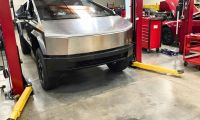This week Lexus brought automotive journalists from around the world together in Nashville to sample the 2015 NX 200t. This is a new model for Lexus, and we took careful notes on the vehicle. Torque News also studied the engine. This new 2-liter turbocharged engine, called 8AR-FTS by Lexus insiders, is all-new for Lexus and company officials have made it clear the engine will migrate to other Lexus models and ultimately find its way into Toyota and possibly Scion models as well. Here is our detailed report on this amazing new engine.
Lexus 2-Liter Engine Architecture
The Lexus in-line, four-cylinder, two-liter engine in the 2015 NX 200t includes a balance shaft with resin gearing. It uses a twin scroll turbocharger. The engine also has an air to liquid intercooler. Fuel is delivered to the engine by both port and also direct injection. The VVT-iW cam and valve timing system can allow the engine to operate in both the Otto and also Atkinson cycles. The exhaust manifold is built into the cylinder head and is cooled to keep exhaust gases from causing too much strain on this super-hot area of the engine. Let’s dive deep into this engine design now and take a closer look at every aspect of what could be the most important Toyota/Lexus engine in a decade.
Lexus 2.0-Liter Engine Turbocharger Details
Turbochargers compress the intake charge to aid in combustion. The twin-scroll turbocharger on the Lexus 2015 NX 200t is different in many key ways from competitors’ turbos. The first unique aspect is that Lexus is making its own turbo. Most automakers don’t make turbos. They source them from companies outside. This slows development; means automakers are fitting a standard part to their engine, rather than making it a custom fit, and the quality program now involves two corporations. Lexus takes ownership of this turbo and it was designed entirely in-house by Lexus and manufactured in the Miyoshi plant. Lexus controls its turbocharger from raw material processing to installation in its vehicle.
Most automakers are using twin scroll turbos now with aim of reducing complexity (compared to twin turbos), space, and of course turbo-lag. Lexus’ design focused on not just power, but also fuel efficiency and emissions. Lexus and Toyota live and die by QDR, quality, durability, and reliability. By making this turbocharger themselves Lexus controls its own QDR destiny.
Lexus’ new turbo design has a focus on reduced friction, efficiency optimized turbine blades, and a reduction in noise, vibration, and harshness (NVH). This focus on reduced NVH is apparent when one stands outside the car while it runs. The engine is silent. Stand next a BMW 2.0 liter turbo, such as that in the BMW X3 28i and you will immediately sense the difference in Lexus’ reduced NVH.
Lexus’ turbo impeller is forged to near its final shape which helps control distortion. The impeller wheel is electron beam welded to continue this attention to dimensional accuracy. The turbo housing itself is a new cast-steel material with reduced nickel content Lexus says helps the casing deal with and resist heat distortion and wear.
Lexus 2.0 Turbo Intercooler Details
Intercoolers remove heat from the compression of the air by the turbo and aid in combustion. A cooler air intake charge is more dense, and thus has more oxygen for combustion (PV=nRT). Lexus mounted its intercooler downstream of the turbo (of course), behind the engine and low in the engine bay. This has many advantages including lower center of gravity (radiators are heavy) and to move the weight back toward the centerline of the vehicle.
Lexus Cam and Valvetrain Details
Lexus uses an ultra-lightweight valvetrain with sodium filled valves. The variable valve timing (VVT) system now used by Lexus is called VVT-iW. The i stands for intelligent, and the W stands for wide. The upshot of the new system is that it operates over a wider segment of the intake timing. The system can advance and retard timing so much that the engine actually operates at times in the Otto cycle, and at times in the Atkinson cycle. Say goodbye to the debate over whether to use Otto (more power overall) or Atkinson (better fuel efficiency in some circumstances).
Lexus Exhaust Manifold Details
The Lexus exhaust manifold is a 4-pipe to 2-pipe to 1-pipe system that is integrated directly into the cylinder head. Lexus uses engine coolant to remove heat from this critical part to prolong life. It also prolongs the range that the engine can be operated in with the optimum air-fuel ratio. Lexus designed the exhaust manifold to work with the turbocharger to reduce exhaust gas pulsing.
Lexus 2.0 Turbo Engine Performance Specifications
In its current form, the new Lexus engine in the NX 200t has a 10:1 compression ratio. It produces a maximum of 235 horsepower through the full range of 4,800 RPM to 5,600 RPM. It also produces 258 lb-ft of torque from a very low 1,650 RPM all the way up to 4,000 RPM. This means that in normal driving the engine uses its peak torque all the time. It also means that the engine has a broad plateau of power at the high end when drivers need power for passing, or merging, or just for fun.
The approximately 4,000 pound NX 200t can accelerate in AWD form to 60 MPH from 0 in just 7 seconds. That is very competitive in the class and will make this a hot engine when used in the Lexus IS 200t. Lexus does not have official fuel economy numbers yet. The company is predicting that the NX 200t will match the fuel efficiency of the BMW X3 without the need for an annoying stop-start system, and without the need for the expensive “Efficient Dynamics” which uses brake energy regeneration to power the electrical system. Lexus can always add these systems later to improve fuel economy if it chooses. Lexus is projecting that the all-weather drive NX 200t will test out at 21 City, 28 Highway, and 24 MPG overall.
Driving the 2015 Lexus NX 200t Turbo
Driving the crossover by Lexus with this engine reveals its refinement. As we mentioned earlier, the lack of any noise is impressive. The engine revs smoothly, and turbo lag is not apparent. In normal starting and cruising one never hears or feels any “turbo sensation.” There is no dead spot at low RPMs. Most importantly, the engine not does not roar to life at 2500 RPMs in the way that many poorly designed turbocharged engines do. Rather, it feels like a small in-line 6-cylinder. Is there a higher compliment?
Hammer the throttle and the engine does begin to produce power immediately, it builds linearly to about 4,500 RPM and then the VVT-iW, variable valve timing system does seem noticeable. This is a very Lexus-like and Toyota-like feeling. I own two V6 Lexus/Toyota engines, and both do this. If one uses the transmission (paddle shifters or the gear selector in M) to start off in the higher ranges, say above 3,500 RPM and then floors the accelerator, from the high 3,000 RPMs to redline the engine is strong.
The sounds the engine makes under hard acceleration are all enjoyable to hear. The Active Sound Control in some models is a nice enhancement to the sounds. Are you not a fan of these systems? It turns off, and it is always off when in Eco mode.
Final Thoughts on the 2015 Lexus NX Turbo Engine
Having driven, heard, and seen the new Lexus turbocharged 2.0-liter engine we now know why Lexus waited so long to introduce it. It is one of the quietest, most fuel efficient engines of its type, and it is made entirely by Lexus which means that its quality, durability, and reliability will be unrivaled. Look for it to be the mainstay of the Toyota/Lexus line for the next decade or more.
Main story photo by John Goreham. Smaller image credits shown when viewed.
Related Stories:
Volkswagen moving to all turbo engines in last ditch effort to revive sales
Turbocharged engine for the 2015 Lexus IS 250 confirmed













Comments
Love to test drive this
Permalink
Love to test drive this vehicle compared to my RX 350
I would like too join up for
Permalink
I would like too join up for news letter,and e-mail list,please?
I would like to correct that
Permalink
I would like to correct that " when in normal driving " the engine is not using its peak torque " at all times" . In order for it to use peak torque at the given rpm the engine needs to be at WOT . The numbers provided is from a SAE certified dyno run which is done at full throttle.
I believe there is room for
Permalink
I believe there is room for the turbo 4 in a Tacoma. I think 2.3 to 2.7 would be ideal and Ron on reg. gas
Lexus should stick to they
Permalink
Lexus should stick to they only thing they know how to many BORING CAMRYS
Let Lexus compete and
Permalink
Let Lexus compete and actually win with a Porsche or even Volkswagen they are both made by Volkswagen, it would be laughable....there is no drag with acceleration in Volkswagen turbo...like I said Toyota...been boring always boring